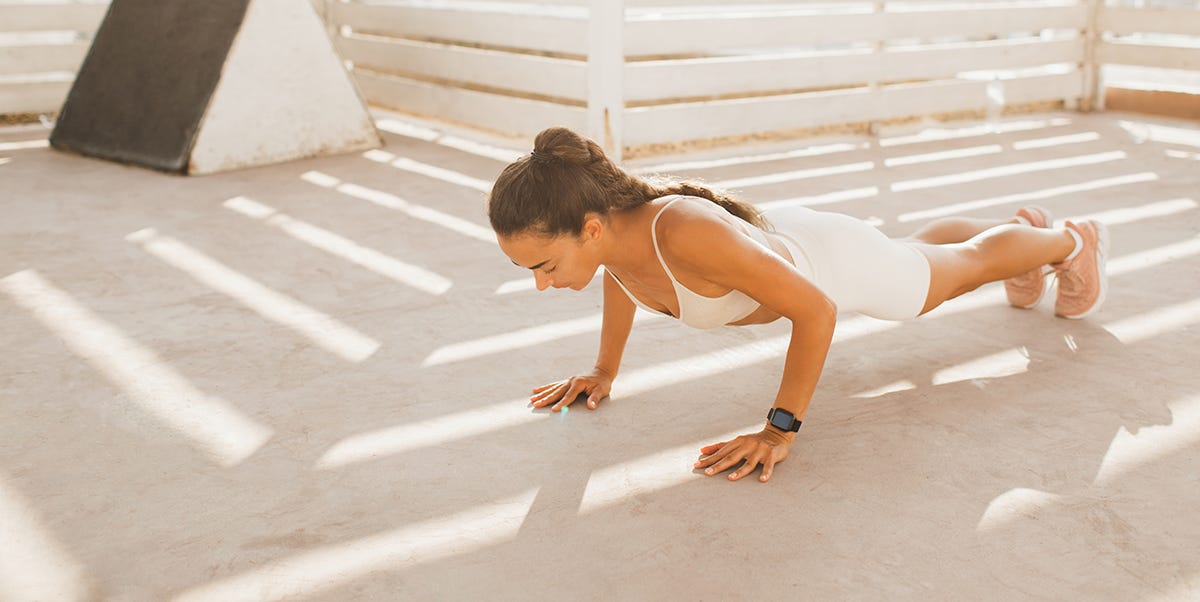Here at Women’s Health, we love a challenge. That’s because an epic, goal-oriented training plan is key to keeping fitness fun and motivational. But recently, a new viral fitness craze has taken the internet by storm: the 11 push-up challenge.
If you’re unfamiliar, this trend originated after orthopedic surgeon and longevity expert Vonda Wright, MD, told author and podcast host Mel Robbins in a now-viral clip that all women should be able to do 11 push-ups.
“[Is] on the knees okay?” Robbins asked, to which Dr. Wright replied, “No.” (Dr. Wright was quick to assure that you can work up to that goal if you’re not there yet though.)
Following the conversation, thousands of TikTok users got on the floor to attempt the sensational goal—and it was harder than you’d expect. But it got us wondering: Why 11 push-ups? We know they’re a great tool for building total-body strength, but what is the reasoning behind this highly specific recommendation?
Here’s what trainers think about how many push-ups women *really* need to be able to do for health and strength benefits.
Meet the experts: Maddison Rotner, CPT, is a certified personal trainer and SOULCYCLE instructor. Shannon Ritchey, DPT, PT, is the founder of Evlo Fitness and host of The Dr. Shannon Show podcast. Sarah Pelc Graca, CPT, is a certified personal trainer and founder of Strong with Sarah Weight Loss Coaching.
Do women really need to be able to do 11 push-ups?
Not necessarily. The research Dr. Wright may be referring to comes from a 2019 study in JAMA Network Open that found that men who could do at least 11 push-ups had increased cardiovascular protection compared to those who could not. However, the study was only done on active, healthy men—not women—so we can’t infer 11 push-ups is the secret to overall health for women.
Push-ups are a compound movement, meaning they work multiple major muscle groups at once, says Sarah Pel Graca, CPT. Every time you’re doing a push-up, you’re working your chest, shoulders, back, triceps, core, glutes, and internal stabilizer muscles like your pelvic floor. Plus, unlike some strength exercises that isolate one muscle at a time, push-ups require coordination, balance, and core engagement, Pelc Graca says. Another perk? You can do them pretty much anywhere since they don’t need any equipment.
Basically, push-ups are a worthwhile exercise, but they’re not the end-all-be-all of your health and fitness status. “One of the biggest issues with this sensationalized trend is that it feels very defeatist to women who can’t accomplish it and are otherwise strong,” says Shannon Ritchey, DPT. “Physics, gravity, and body proportions all play a role in a person’s ability to do a push-up and how many they can do, so 11 push-ups may not always be a reliable indicator for a person’s overall strength.”
For example, if you have long arms, you have longer levers and further to lower, so there will be more challenge and load to your muscles in a push-up, Ritchey says. If you’re larger chested, you’ll also have more weight to move, ultimately making a push-up more challenging.
In other words, 11 push-ups isn’t a one-size-fits-all recommendation. “People get too wrapped up in the specific exercise and forget that the purpose of the exercise is to increase strength, muscle, and potentially endurance in the upper body,” Ritchey says. “If you can choose an exercise that better suits your body and physicality but achieves the same goals (like a bench press, chest press, or pec fly), that’s what matters.”
So no, all women do not need to be able to do 11 push-ups, per our experts. “‘Need’ is such a loaded word, because there is nothing we need [to do], but I do think being able to do 11 push-ups can be a really empowering benchmark for functional strength,” Maddison Rotner, CPT, says.
So, how many push-ups do women really need to do for health benefits?
Again, there isn’t a universal number of push-ups every woman needs to be able to do. “Any consistent push-up practice will yield benefits, especially if you’re starting from zero, and even doing two to five high-quality push-ups a day can improve muscular strength, posture, and stamina,” Pelc Graca says. “It’s more about progress over perfection, so instead of a hard number, the goal should be increasing what you can do over time—whether that’s three, eight, 11, or beyond.”
If you are goal-oriented, these are the targets our experts recommend you work toward:
Overall Health: For overall health, including cardiovascular support and bone density, working up to 10 to 15 full push-ups is a good goal, according to Pelc Graca. Why? It promotes a solid foundation of upper-body and core strength.
Strength: For advanced strength goals and muscle hypertrophy, aim for 15 to 20 (or more) full push-ups, says Pelc Graca. It’s also beneficial to incorporate variations like decline push-ups or push-ups with shoulder taps. Why? It builds muscular endurance and challenges your muscles to perform even when fatigued.
That said, even a few push-ups a day can offer real benefits if you’re doing them with proper form. “Five high-quality push-ups will do more for you than 20 push-ups where you’re compromising form, so I’d start with what challenges you and aim for consistency and progression over time,” Rotner says.
And if you need to do push-ups on your knees, go for it. “Doing push-ups on your toes loads the upper body more than on your knees, however, when we look at what improves strength and muscle, what matters is that you are significantly challenging the targeted muscle group close to failure, no matter what position your body is in,” Ritchey says. “If push-ups on your knees significantly load the upper body and get you close to failure, that variation will absolutely be an effective option for building strength, muscle, and endurance in the upper body.”
How To Do A Push-Up With Proper Form
- Start in a high plank position, with feet slightly wider than hip-width apart and shoulders stacked over wrists to avoid stress on shoulders and wrist joints.
- Keep ribs in, core engaged, and butt tucked under to maintain alignment and protect lower back.
- Lower body down with elbows pointing 45-degrees away from body and gaze just in front of hands.
- Then, push into palms and drive body back up, maintaining same shape and alignment. That’s 1 rep.
Once form is locked-in and you’re ready to increase reps, Ritchey, Rotner, and Pelc Graca suggest the following tips:
- Start with incline push-ups. Put your hands on a sturdy bench, table, or kitchen counter to build form and core engagement. Alternatively, you can do push-ups on your knees.
- Use tempo training. Instead of whipping through reps, build strength by moving slowly on the way down and explosively on the way up. If needed, complete the lowering phase on your toes and drop to your knees on the ascent.
- Train your entire upper body. Push-ups are great, but you should also incorporate additional moves in your training such as planks, chest presses, and rows to build strength in the triceps, chest, and core. When overall strength improves, push-ups improve.
- Be consistent. Consistency is crucial for building strength and endurance. Even three to five reps a day can help (or 11, if that’s your goal).
- Set micro-goals. Aim to improve your push-up count by one to two reps every week.
Need extra support and accountability? Check out the Women’s Health 30-Day Push-Up Challenge, created exclusively for WH+ members. It’s specifically designed to help you sculpt muscle and feel strong from head to toe, no matter your fitness level or push-up expertise.
Andi Breitowich is a Chicago-based writer and graduate student at Northwestern Medill. She’s a mass consumer of social media and cares about women’s rights, holistic wellness, and non-stigmatizing reproductive care. As a former collegiate pole vaulter, she has a love for all things fitness and is currently obsessed with Peloton Tread workouts and hot yoga.
Read the full article here




